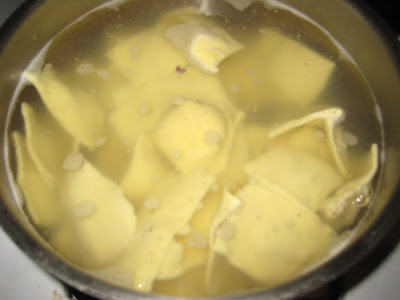
Artichoke Olive Raviolis
My husband’s youngest brother recently passed through town and spent some time with us. I always feel so happy whenever we have guests staying with us; not only am I honored that people travel long distances to (among other things) come see us, I can also socialize in the morning and at night while hanging out in my pajamas.
In our first evening together, after a period of catching up and slowly watching the sunlight drain out of our living room, the conversation turned to dinner. This dish was a bit of a gamble, but it came out really well. The bad news is you will need a pasta-maker to make this meal. The good news is that you don’t need a special ravioli attachment, if you are able to handle delicious raviolis that may be somewhat asymmetrical.
Pasta
For the pasta, you will want to prepare long, thin sheets of pasta, as if you were making lasagna noodles. They should also be the same thickness as lasagna noodles. I used the basic semolina pasta recipe that came with my Kitchenaid pasta attachment, but I imagine whole wheat pasta would also be delicious. (If you don’t have a pasta recipe on hand, google it. I would include the one I used and while I doubt Kitchenaid’s extremely basic recipe is proprietary, am erring on the side of respecting their potential intellectual property.)
Filling
1 cup ricotta cheese
1 jar or can of artichokes
¼ cup of pitted kalamata olives
pinch of salt
half a lemon
Dice the artichokes. You want them to be extremely fine when you mix them with the ricotta. Do the same with the olives and combine with the ricotta and salt. Add the juice from half a lemon, or more to taste. There really isn’t a right or wrong ratio here, it’s more about what tastes good to you. As long as the mixture is creamy enough to use as a ravioli filling (e.g. no big chunks of artichoke hearts), you are good to go.
Take the lasagna noodles and cut them into roughly two inch pieces and add about a teaspoon of filling in the middle of each noodle. (Again, this can very depending on the length and width of your noodles, and how much filling you want.) I’ve always thought really fat noodles would burst but my brother-in-law made a nice fat ravioli that held up quite well when cooked.
Fold the noodle over the filling and press down around the edges until well-sealed. Make sure no filling is leaking out. Trim the edges with a sharp knife so the sides look more or less even. Repeat, repeat, and repeat.
After your ravioli are prepared, add them to a pot of well-salted, boiling water and cook until they look pillowy and float to the surface.
We had some leftover pasta sauce we needed to use up, but I recommend serving the ravioli with just a little bit of olive oil and parmesan. I think a tomato sauce is just too overpowering for what is already a nicely complex flavor.
As we can all attest, this filling is also delicious smeared on bread. If you don’t have a pasta-maker, I bet it would make a really good appetizer if you placed a bit on sliced French bread and heated them up until the ricotta got all gooey. Yum!
MHM





No comments:
Post a Comment